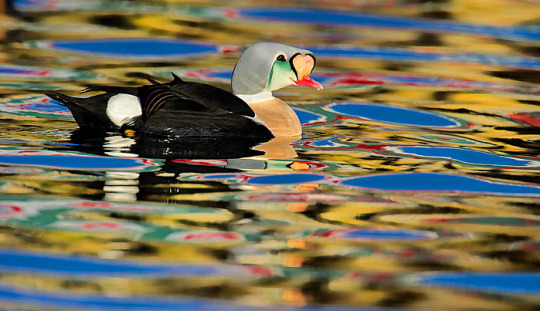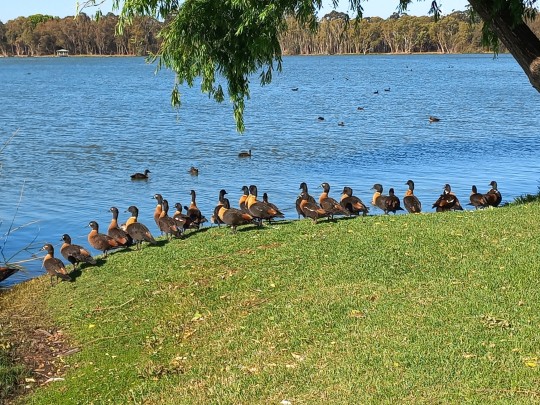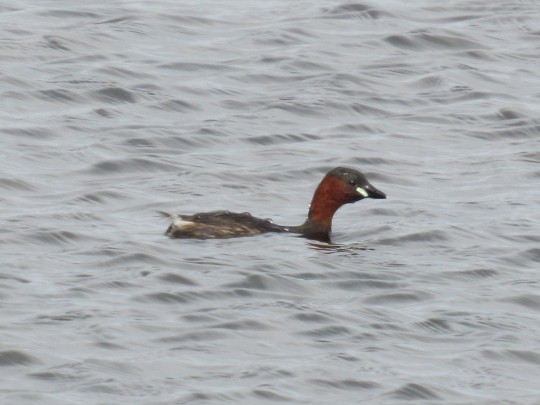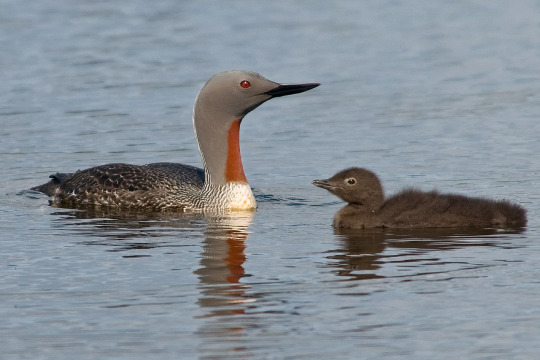#waterbirds
Text

Today's bird is a Pacific Black Duck doing a perfect duckdive (and its buddy chilling on the log)
291 notes
·
View notes
Text

Loon bird. Their calls are so spooky but they're really cool.
Trying a screen recorder instead of the built in time-lapse recorder. I'm having a blast with a free video editor.
80 notes
·
View notes
Text
BOTD: American Coot

Photo: Heather Paul
"Coots are tough, adaptable waterbirds. Although they are related to the secretive rails, they swim in the open like ducks and walk about on shore, making themselves at home on golf courses and city park ponds. Usually in flocks, they are aggressive and noisy, making a wide variety of calls by day or night. They have strong legs and big feet with lobed toes, and coots fighting over territorial boundaries will rear up and attack each other with their feet. Often seen walking on open ground near ponds. In taking flight they must patter across the water, flapping their wings furiously, before becoming airborne."
- Audubon Field Guide
#birds#american coot#birds of north america#north american birds#coots#rails#waterbirds#birds of the us#birds of canada#birds of mexico#birds of central america#birds of the caribbean#birding#birdblr#birblr#bird of the day#Fulica americana
78 notes
·
View notes
Text

King Eider (Somateria spectabillis)
Photo by Ben Cranke
#Somateria spectabillis#king eider#eider#waterbirds#aquatic birds#birds#colorful birds#water reflections#colorful water#bird photography#animals#wildlife#nature
85 notes
·
View notes
Text

A snapshot of a coot.
#coot#coots#waterbird#waterbirds#water bird#water birds#aquatic bird#aquatic birds#bird#birds#a coot#snapshot#snapshots#picture#pictures#image#images#nature#animal#animals
17 notes
·
View notes
Note
thoughts on puffins? i’m gonna go on a trip in the first week of may to go see some!
OH I LOVE PUFFINS!!! they're such delightful creatures and they're fluffy and soft!!!!!
the only fun fact i have about puffins right now is that in the filming of a star wars movie (last jedi i think? idrk), they had to invent a new animal because they just couldn't get the puffins away from where they were filming!


fundamentally unserious animals, i hope you enjoy them!!!!
7 notes
·
View notes
Text

9.10.2003
#aix galericulata#birds#mandarin ducks#birding#vienna#waterbirds#urban nature#ducks#urban wildlife#water birds#ari fink photography#wildes wien#wiener vögel#wild vienna#9.10.2003
12 notes
·
View notes
Text

A very very quick Gastornis WIP, based on a Takahē before I head off to the psychologist.
I just saw a headline with a photograph of a Takahē and my brain went "mini Gastornis." Looking at illustrations of both skeletons made me feel confident in thar direction. I'm really proud of how the head came out. I haven't seen many paleo art where Gastornis's ISN'T ratite like, so I want to try a "round" giant waterbird gastornis. Unfortunately, before I realised what I was doing, I gave it a moa neck, and now I have no choice but to redo the head ( ; ゚Д゚). At least I have a photo of it now. A lot of the leg anatomy is messed up anyway, but I think I would like someone who is more skilled at paleoart than me try this concept out.
12 notes
·
View notes
Text

A large gathering of Australian Shelducks (28/11/23)
7 notes
·
View notes
Text

little grebe (tachybaptus ruficollis), ireland
#podicipediformes#podicipedidae#tachybaptus#little grebe#birds#waterbirds#bird photography#birdwatching#display flight#little grebes are certified babies
3 notes
·
View notes
Text

Cormorant drying it's wings. Bourgoyen, Ghent, Belgium
#cormorant#bird#birds#wildlife#photography#birds of the marsh#waterbirds#marsh#marshland#bourgoyen#ghent#9000#flanders#belgium#animal kingdom#animal behavior#original photographers#photographers on tumblr#lensblr#original photography#pws#nature
19 notes
·
View notes
Text
BOTD: Red-Throated Diver

^image credit: David Karnå / Wikimedia Commons / CC BY 3.0
Red-Throated Diver (Gavia stellata)
Also called the Red-Throated Loon, they are the smallest of the world's Loons/Divers ranging from 55 to 67cm (22 to 26 inches) in length. In the wild, the oldest known Red-Throated Diver lived for over two decades. As recently as the 1800s, the behaviour of the Red-Throated Diver was used to forecast the weather; according to typical beliefs at the time, birds flying inland or giving shorter cries predicted good weather, meanwhile those flying out to sea or giving longer cries predicted rain.
#red throated diver#red-throated diver#red-throated loon#red throated loon#loon#water birds#waterbirds#birding#birds#bird of the day#gavia stellata#bird facts#birdwatching#birds of north america#birds of the uk#british birds#birds of america
89 notes
·
View notes
Text

How many waterbirds do you see in this pattern? One is a migratory raptor!
Every January bird lovers and scientists join the Asian Waterbird Census or AWC. They count waterbirds, or birds “ecologically dependent on wetlands” (Wetlands Int. 2018). Wetlands include coasts, mangroves areas, rivers, lakes, marshes and other similar areas.
Join the count! Recommended dates for counting are January 6 to 21. Forms, guides, and more information can be found at the South Asia Wetlands International website at: bit.ly/awc2024
Or contact your local biologist or bird-lover at Wetlands International Philippines, Haribon Foundation, Department of Environment and Natural Resources (DENR), or local environment group.
4 notes
·
View notes
Text
BOTD: Anhinga

Photos: Doug Greenberg
"A long-necked, long-tailed swimmer of southeastern swamps. Often seen perched on a snag above the water, with its wings half-spread to dry. Can vary its buoyancy in water, sometimes swimming with only head and neck above water (earning it the nickname of 'Snakebird'). Often solitary when feeding, it roosts in groups and nests in colonies. Looks rather like a cormorant when perched, but not in flight, when the long tail may be spread wide as the Anhinga soars high on outstretched wings. Anhingas are silent at most times, but around nesting colonies they make various croaking and clicking sounds."
- Audubon Field Guide
#birds#anhinga#birds of north america#north american birds#anhingas#waterbirds#birds of the us#birds of mexico#birds of central america#birds of the caribbean#birds of america#american birds#bird#birdblr#birblr#birding#bird watching#Anhinga anhinga
75 notes
·
View notes
Text

#photography#nature photography#nature#outdoors#nikon#adventure#forest#greenery#nature hikes#wildlife photography#waterphotography#wildlife#wildlife photos#tree branches#wildlife pictures#exploring#wild animals#waterbirds#water birds
133 notes
·
View notes
Text
In the spray
Using a slow shutter speed to capture wave movement.
On a windy, choppy afternoon at the Rotorua lakefront, Dad and I photographed this male pāpango – New Zealand scaup – hunker down in a pretty wet and horrible perch for a nap. There were constant splashes and spray from wavelets crashing into the shore around the fallen trunk that he had chosen, along with his mate. They seemed remarkably content, water pouring over them and sluicing off their…

View On WordPress
32 notes
·
View notes